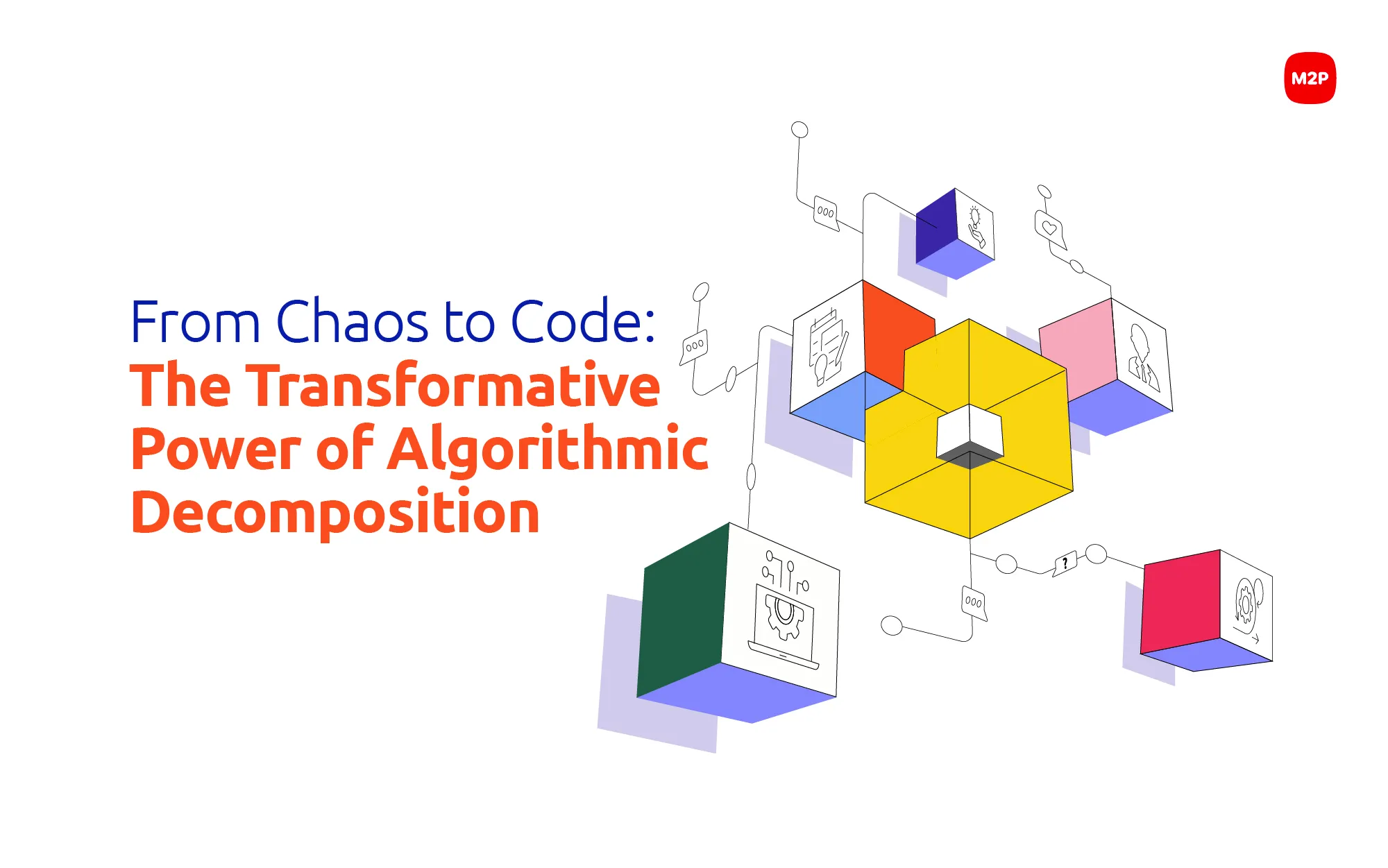
M2P Fintech
Fintech is evolving every day. That's why you need our newsletter! Get the latest fintech news, views, insights, directly to your inbox every fortnight for FREE!

In the world of problem-solving, especially in technology and engineering, complexity is a constant companion. Whether you're building a scalable software system, designing a new product, or optimizing a business process, the ability to break down problems into smaller, manageable parts is essential.
This is where decomposition, a core principle of algorithmic thinking, comes into play.
Decomposition is the process of breaking a complex problem into smaller, more manageable subproblems. Each sub-problem can then be tackled individually, making the overall challenge less daunting and more structured.
Think of it as solving a puzzle: instead of trying to place all the pieces at once, you start with the edges, then group similar colors or patterns, and gradually build the full picture.
Decomposition is often the first step in algorithmic thinking because:
It clarifies the problem space, bringing definitive clarity to the entire problem
It enables parallelism, allowing different parts to be worked on simultaneously
It facilitates reuse, meaning common subproblems can be solved once and then efficiently reused
It simplifies testing and debugging because smaller units are inherently easier to verify
These benefits aren't theoretical; they are the foundation of major technological shifts.
To see these foundational principles of algorithmic thinking in action, let's explore two key areas of technology.
In modern software engineering, monolithic applications are being replaced by microservices, which are independent, loosely coupled services that handle specific business capabilities. An e-commerce platform might decompose its system into these core services:
User Service: Handles authentication and user profiles
Product Catalog Service: Manages product listings
Order Service: Processes customer orders
Payment Gateway: Handles transactions
Notification Service: Sends emails and alerts
This structure allows each service to be developed, deployed, and scaled independently, enabling agility and resilience.
Compilers are complex systems that translate high-level code into machine code. To manage this complexity, they are typically decomposed into a series of processing stages.
Lexical Analysis: Tokenizing the input
Syntax Analysis: Parsing tokens into a syntax tree
Semantic Analysis: Ensuring logical correctness
Optimization: Improving performance
Code Generation: Producing machine code
This layered decomposition allows compiler engineers to focus on one aspect at a time, improving maintainability and extensibility.
Before diving into design or architecture, it’s crucial to define the objective. This could be a business goal, a user experience target, or a technical outcome. Think of this as setting the destination before planning the route.
Ask: What is the system supposed to do?
Example: If you’re designing a payment platform, the end goal might be ‘Enable secure, fast, and flexible transactions across multiple products.’
This clarity helps guide all decomposition decisions and ensures alignment with the bigger picture.
Once the goal is clear, break the system into high-level modules or domains. These are the main building blocks that represent distinct responsibilities or functionalities.
Ask: What are the core areas of concern?
Example: In a payment system, major components include:
User management
Transaction processing
Fraud detection
Notification service
Reporting & Analytics
This step helps isolate concerns and makes the system easier to understand and manage.
Each major component can usually be decomposed into subcomponents or tasks. This is where you move from macro- to micro-level design.
Ask: What are the internal responsibilities of each component?
Example: For ‘Transaction Processing’, you might break it down into
Validation
Authorization
Settlement
Reconciliation
This step enables parallel development, improves testability, and enhances scalability.
Once components are identified, define how they interact. This involves specifying interfaces, contracts, or APIs that allow components to work together without being tightly coupled.
Ask: What data flows between components? What protocols or formats are used?
Example: The ‘User Management’ module might expose APIs like:
GET /users/{id}
POST /users
DELETE /users/{id}
Clear interfaces ensure modularity, interoperability, and ease of integration.
Decomposition is not a one-time activity. As you gather feedback, encounter edge cases, or scale up the system, you may need to restructure components, redefine interfaces, or reassign responsibilities.
Ask: Is the current structure still optimal? Are there bottlenecks or overlaps?
Example: You might realize that ‘Fraud Detection’ needs to be split into real-time and batch processing modules due to performance needs.
Iteration ensures the architecture remains robust, adaptable, and aligned with evolving requirements.
To see how these principles define clean architecture, let's examine simple code examples that illustrate practical decomposition.
Let’s say we’re building a simple e-commerce checkout system. Instead of writing one large function, we decompose it into smaller services:
# cart_service.py
def calculate_cart_total(cart_items):
return sum(item['price'] * item['quantity'] for item in cart_items)
# payment_service.py
def process_payment(amount, payment_method):
# Simulate payment processing
return f"Payment of ₹{amount} using {payment_method} successful."
# order_service.py
from cart_service import calculate_cart_total
from payment_service import process_payment
def checkout(cart_items, payment_method):
total = calculate_cart_total(cart_items)
confirmation = process_payment(total, payment_method)
return confirmation
# Example usage
cart = [{'price': 1000, 'quantity': 2}, {'price': 500, 'quantity': 1}]
print (checkout(cart, 'Credit Card')) Takeaway: By assigning each service a single concern (cart, payment, order), the system becomes inherently modular and highly scalable.
The Model-View-Controller (MVC) pattern serves as a textbook example of decomposition in web development:
# model.py
class Product:
def init(self, name, price):
self.name = name
self.price = price
# view.py
def render_product(product):
return f"<h1>{product.name}</h1><p>Price: ₹{product.price}</p>"
# controller.py
from model import Product
from view import render_product
def show_product_page():
product = Product("Wireless Mouse", 799)
return render_product(product)
# Example usage
print(show_product_page()) Takeaway: Explicitly separating data (Model), UI (View), and logic (Controller) allows for far better maintainability and testability.
Decomposition is more than a technique; it's a critical mindset that empowers you to approach overwhelming complexity with absolute clarity and confidence. Whether you're architecting a cloud platform, designing a mechanical system, or writing a basic algorithm, always begin by asking:
“How can I break this down?”
This thought leader article was authored by Hemachandar Ejamanam Chakravarthy, Director, Engineering, M2P.
Follow us on LinkedIn and Twitter for insightful fintech bytes curated for curious minds like you.